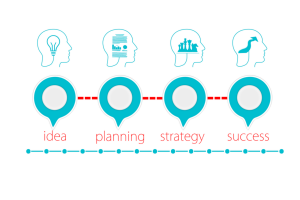
I’m not going to lie to you. Raising your rates with existing clients is easier said than done. Mainly because you take all the nerves, concerns and beliefs that you have about your pricing, and compound them with all the nerves, concerns and beliefs you have about communicating with clients. That’s scary. I get it.
But good news my dear Ambitious Entrepreneur! It’s more than possible. You can do it. And with practice, you can even do it without breaking much of a sweat.
Here’s how.
When To Raise Rates
Deciding when to raise rates with existing clients is less about the calendar, and more about your specific engagement with them. Ideally, you’ll be having the price increase conversation before the end of your work together. The goal? A smooth transition from one price to the next. For example:
Coaching Packages: If a client has purchased a 6-pack of coaching sessions, the best time to communicate the price increase is between the 5th and 6th meeting you’ll have with them. Why? Because it gives them time to wrap their heads around the new price, and gives you an opportunity to absolutely knock their socks off with a great final session experience. Seriously – they’ll be all loved up and excited to purchase another package. At the new price.
Ongoing support/contract/retainer services: If you’re working under a contract that runs continuously, check the contract termination clause to see how much notice needs to be given before the end of the relationship. If it’s 30 days, aim to have a conversation with your client at least 60 days before your new price would take effect. This gives them time to rework budgets, and gives you time to – you guessed it – absolutely nail the delivery of services over the next 30 days. When they agree to the new price, you can amend the contract to reflect the new price well before it expires.
How To Communicate
You can have the most fabulous service in the world, but communicating a price increase can go south fast if you pick the wrong method. Here’s a guide to what works well, when.
In person
If you work with a local client and usually see them in person, this is the obvious best choice. Same goes if you’re not local, but it’s a mega-client. If your contract with them is worth big bucks, taking the time and energy to travel to them for an in person presentation of your new pricing structure may be worthwhile.
Why It Works: Being face-to-face is a great relationship builder, and it will be easier to answer their questions or tailor your approach to their feedback when you’re side by side. Never underestimate the power of walking through a proposal with a client.
Phone or Skype
n addition to being far more convenient than hopping on a plane, if you regularly meet with clients using one of these platforms, it’s a great way to communicate an increase without having it feel dramatic. (We all know how stressed out we get when someone says ‘we need to talk…’ Same goes for our businesses.
Why It Works: All of the power of instant-feedback without the transit time.
I’m a fan of email…but not for sending clients a price increase. There are two dangers to just sending over a quick email that far outweigh the relief you feel of not having to actually say the words ‘I’m raising my price’. 1) There’s no feedback! The news of the higher price lands in their inbox with a thud. And if they freak out, you’re not there to walk them through the change. 2) It’s a relationship killer. If you’ve been working closely with a client for any length of time, you’ve got a rapport. Maybe even a budding business friendship. Sending an email is cold.
How To Make It Work: Use emails as a follow-up to the conversations you have. Discuss the new price, explain when it will take effect, and answer any questions – and then send an email with a recap and reminder of the new price. It’s a must-have paper trail.
What To Say
Now you know when to raise your prices, and are giving excellent advance notice. You’re also putting on your Big Ambitious Entrepreneur pants and having a conversation about it, rather than lobbing an email grenade over the wall. But what will you actually say to the client? Here are some Pro Tips for you to use.
Pro Tip #1: Avoid giving too many justifications.
The more you go on about the cost of bananas increasing, how inflation is calculated this year, and the amount of research you did to calculate the new price…the more it’ll sound like you’re convincing yourself. No client is going to buy into that value if you haven’t.
Pro Tip #2: Avoid being apologetic.
Unless you’ve let this go until the last minute and are apologizing for giving short notice, there’s no need for ‘I’m Sorry’ to escape your lips. Don’t be sorry for charging a price reflective of the value you deliver to your clients. Ever.
Pro Tip #3: If you love working with a client, let them know it!
Don’t be shy to tell them how much you’ve enjoyed working on their project, getting to know their business, or even how much you enjoy working with them personally. People want to work with people who are enthusiastic about what they do.
Pro Tip #4: Roll out the proven value cart.
Have you helped them drop a dress size? Reconnect with their inner child? Finally see conversions on their site? Remind them of that. Especially if you’ve been working together for a while, they may have forgotten some of the early wins they had because of you.
What could this look like?
Opening the discussion: “Hi Sarah! I wanted to share some news with you that will effect our work together starting this Fall.”
Taking Care of Business: “I’ll be increasing the price of my consulting services to $ 2500 per month, starting October 1st when our contract renews.”
Showing enthusiasm: “I’ve really enjoyed getting to work side-by-side with you over the past few months.”
Reminder of value: “I love thinking back on where we started together, and all the greatness we’ve achieved. Your sales are better than ever, subscribers are growing by double-digits, and I’m still pinching myself about that feature in Hot New Thing magazine.”
Wrap Up: “I’ll send over an update to the contract for you to take a look at, and we can take care of the refresh now so that our work together keeps buzzing along.”
Of course, your client will be participating in the conversation – so don’t try and map out a whole script and then stick to it 100%. Just create some speaking points, give yourself a mini-rehearsal (especially when it’s time to say what your new price is! Funny how numbers get us all tongue tied…) and then go with the flow of the conversation.
(212)
Report Post






